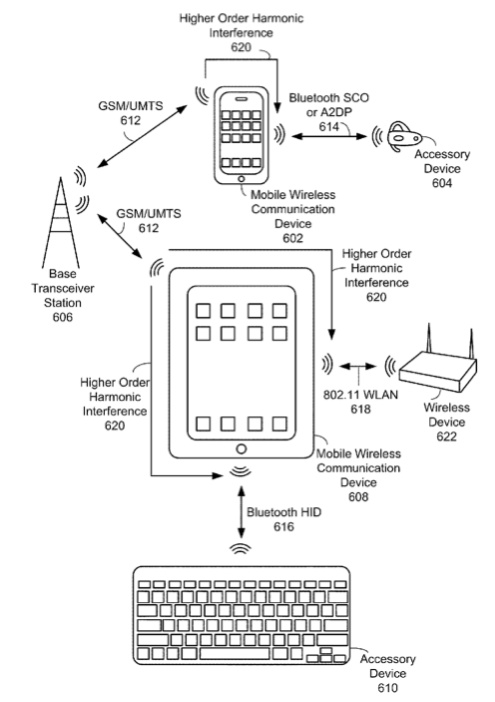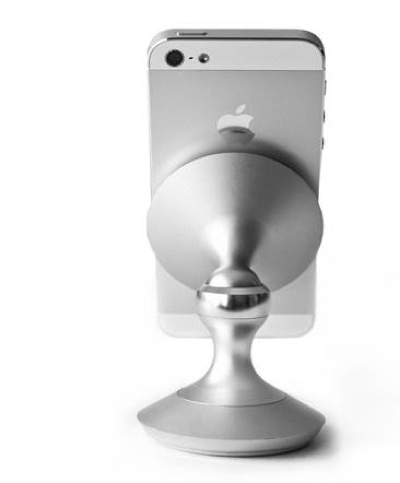Apple is working on ways to lessen wireless interference on devices such as the iPhone, per a new patent (number 20110237246) for “Wireless Interference Mitigation” has appeared at the US Patent & Trademark Office.
The patent involves mitigating interference in a mobile wireless communication device by using an estimation of the performance impact of interfering signals generated by a wireless cellular transmitter and received by a co-located wireless local area network receiver. Wireless local area network frequency band usage is modified based on the performance impact estimation and the state of the wireless cellular and wireless local area network connections.
The estimation accounts for properties of the wireless cellular transmitter and wireless local area network receiver as well as operational characteristics of the wireless cellular and wireless local area network connections. Indranil Sen is the inventor.
Here’s Apple’s background and summary of the invention: “Mobile wireless communication devices, such as a wireless cellular telephone or a wireless enabled computer tablet, can provide a wide variety of communication services including, for example, voice communication, text messaging, internet browsing, and audio/video streaming. Different communication services on mobile wireless communication devices can use one or more different communication protocols that transmit and receive in separate or overlapping bands of radio frequency spectrum.
“Different bands of radio frequency spectrum are allocated for different services, some strictly licensed to particular wireless operators, while other frequency bands can be open for shared common use. Ideally transmissions in one frequency band do not interfere with the reception of transmissions in another frequency band; however, the advent of mobile wireless communication devices that include multiple wireless transceivers, each configured to operate with a different communication protocol and placed in relatively close proximity to each other in the mobile wireless communication device can result in interference between them.
“Mobile wireless communication devices offer short range connections to wireless accessory devices, medium range connections to wireless network access points, and long range connections to cell towers, thereby providing flexibility and near ubiquity for connecting a user to a wide array of communication services. For example, voice communications can be realized over a 3G communication link using a global system for mobile communications (GSM) protocol or using a voice over internet protocol (VoIP) packet protocol through a wireless local area network connection.
“Some mobile wireless communication devices can support seamlessly transferring a communication link between connections that use different protocols. Several national and international standards organizations develop and specify communication protocols that can enable consistent performance and compatibility between products provided by different manufacturers.
“While each communication protocol can require that transmissions by mobile wireless communications devices using the protocol be restricted to not transmit above a defined power spectral density mask, i.e. keep radiated transmit power below certain levels across different radio frequency bands, current mobile wireless communication devices include receivers capable of detecting radio frequency signals at very low power levels. With a relatively high power transmitter located close to a sensitive receiver in the same mobile wireless communication device, providing adequate isolation between them can prove quite challenging.
“Isolation between a transmitter and a receiver co-located in the same mobile wireless communication device can use specific antenna design, shielding, filtering and placement to minimize receiving interfering radio frequency power in one receiving antenna from another transmitting antenna. Current mobile wireless communication devices can be quite compact in size, and the maximum physical distance possible on such small devices between a transmitter and receiver can limit the amount of radiated radio frequency power loss resulting from antenna placement. Thus there exists a need for a method to mitigate interference between radio frequency transceivers placed in the same mobile wireless communications device.
“This paper describes various embodiments that relate to methods to mitigate interference between different transceivers in a mobile wireless communication device. A method to reduce interference between a first transmitter and a second receiver in a mobile wireless communication device based on estimating interference into the second receiver and coordinating transmissions by the first transmitter is described.
“In one embodiment a method of mitigating interference in a mobile wireless communication device includes at least the following steps. A performance impact to signals received by a first transceiver through a wireless local area network connection due to interference from signals transmitted by a second transceiver over a wireless cellular connection is estimated. The first and second transceivers are co-located in the mobile wireless communication device. The wireless local area network connection is changed to use a second frequency band based on the performance impact estimation.
“The estimation of the performance impact of interference between the first and second transceivers is periodically repeated while the wireless local area network connection and wireless cellular connection are active. In a representative embodiment, the estimation accounts for properties of the transmitter of the wireless cellular connection and the receiver of the wireless local area network connection as well as operational characteristics of the wireless cellular and wireless local area network connections.
“In another embodiment, a mobile wireless communication device comprises a first transceiver that receives signals through a wireless local area network connection, a second transceiver that transmits signals through a wireless cellular connection, and a control processor coupled to the first and second transceivers. The control processor mitigates interference in the mobile wireless communication device.
“The control processor estimates the performance impact of signals received by the first transceiver from signals transmitted by the second transceiver. The control processor changes the wireless local area network connection to not use a portion of a first frequency band based on the performance impact estimation.
“The estimation and change of frequency band usage is repeated periodically. In a representative embodiment, the estimation accounts for properties of the transmitter of the wireless cellular connection and the receiver of the wireless local area network connection as well as operational characteristics of the wireless cellular and wireless local area network connections
“In yet another embodiment, a computer readable medium for tangibly storing computer program code executable by a processor for mitigating interference in a mobile wireless communication device is described. The computer readable medium includes computer program code for estimating a performance impact to signals received by a first transceiver of the mobile wireless communication device through a wireless local area network connection by signals transmitted by a second transceiver of the mobile wireless communication device through a wireless cellular connection.
“The computer readable medium further includes computer program code for changing the wireless local area network connection to use a second frequency band based on the performance impact estimation. The computer readable medium also includes computer program code for periodically repeating the estimating the performance impact and changing the wireless local area network connection while the wireless local area network and wireless cellular connections are active.
“In still another embodiment, an apparatus for mitigating interference in a mobile wireless communication device is described. The apparatus can include at least means for estimating a performance impact to signals received in a first frequency band by a first transceiver of the mobile wireless communication device through a wireless local area network connection with a first wireless local area network partner device from signals transmitted by a second transceiver of the mobile wireless communication device through a wireless cellular connection, means for changing the wireless local area network connection to use a second frequency band based on the performance impact estimation, and means for periodically the estimating and changing while the wireless local area network and wireless cellular connections are active.”
— Dennis Sellers


![[NPL] AOL and Sun Form Strategic Alliance](https://www.mactech.com/wp-content/themes/Extra/images/post-format-thumb-text.svg)
